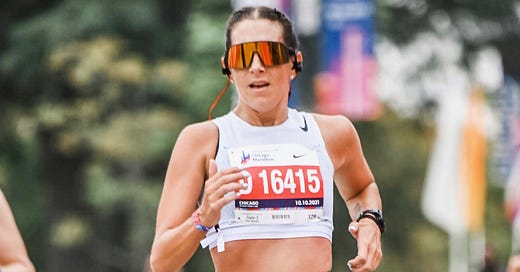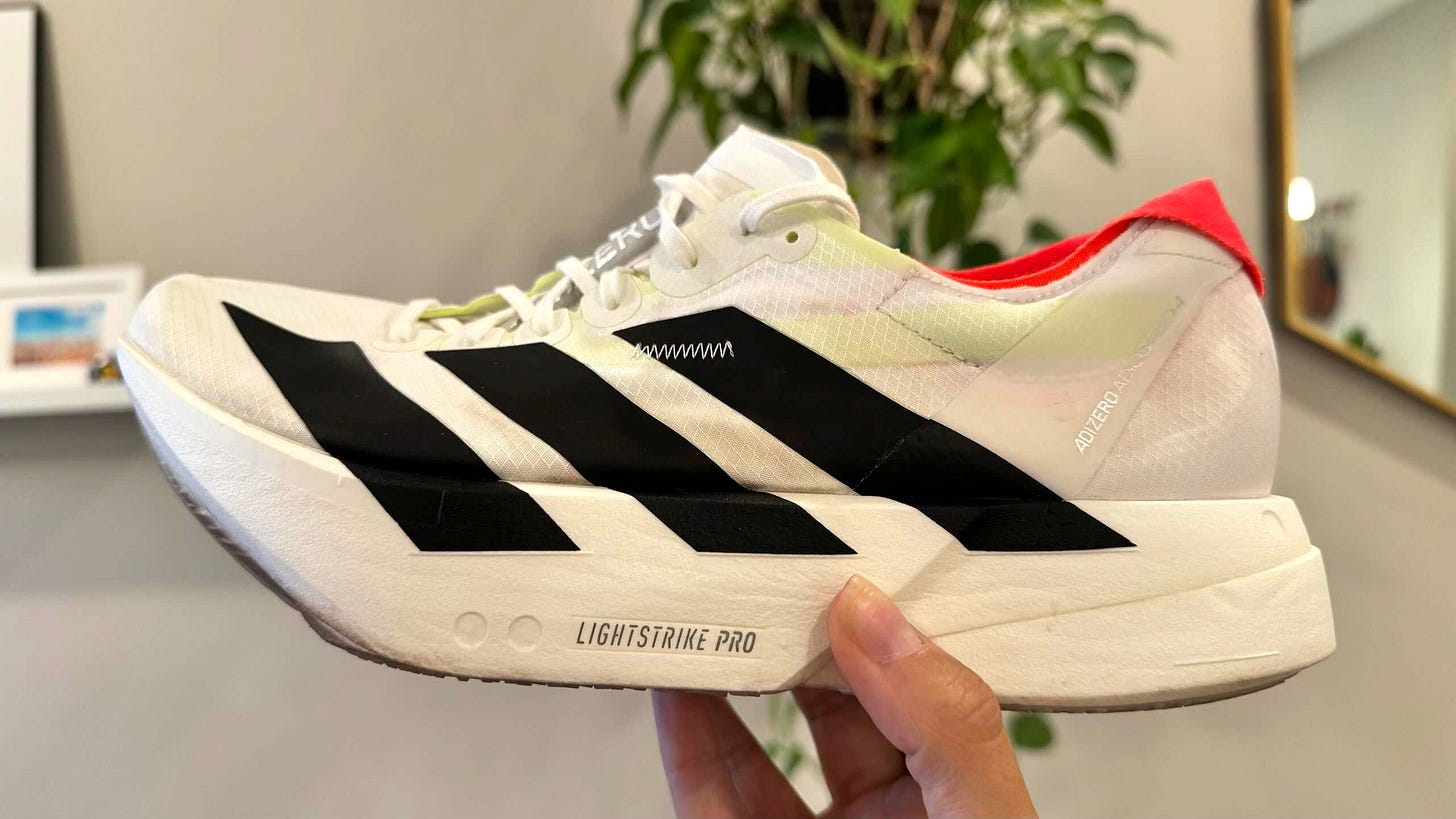A Marathon Shouldn’t Feel Easy
No matter how fit or fast you get, racing 26.2 miles will be a challenge.
I’ve made this mistake a few times: I show up on race day, hyping myself up, confident in my training and the fact that I know I can cover the distance, and I tell myself “you got this—it’s going to be easy.”
Joke’s on me: A goal marathon should never feel “easy.”
Here’s what would feel easy: running the same pace I ran in my first marathon. That pace is now slower than the pace I run nearly all of my easy runs at, because I have nine more years of running experience on my legs. But the goalpost has moved. My current goal marathon pace is minutes faster; if that pace was “easy,” I would have already run it.
I think we sometimes expect that because we’ve done the work, the event itself should feel easy. Isn’t that the point of training? Not really. In training, “you’re callousing and conditioning your body—your central nervous system, your tissue capacity, your muscular structure—to handle the demands of running 26.2 miles,” coach Rebeka Stowe recently told me for an Outside Run article (I really liked the idea of ‘callousing’ your body against the distance). It also teaches you how to be comfortable with discomfort—one of the most common phrases in endurance running. Training is all about learning how to sustain your goal pace, but that doesn’t mean doing so is going to feel easy.
“Pacing…is the art of finding the most aggressive pace that can be sustained to the finish line without exceeding one’s maximum tolerance for perceived effort,” Matt Fitzgerald writes in his book How Bad Do You Want It (I like to revisit this book on sports psychology before a big race).
It’s a balancing act, really. The more discomfort you can handle, the faster you’ll be able to go—but you have to accept that it’s going to be hard and it’s going to hurt. That acceptance can make all the difference, it’s why mental toughness is so important. Mental toughness requires a challenging goal, the belief that you can achieve it, and the self-control to execute on it, according to a 2022 study published in the International Journal of Sport and Exercise Psychology. If running marathons was easy, everyone would run them—and yet only about 0.01 percent of the world's population has one , according to a 2019 report from the International Institute for Race Medicine.
This isn’t meant to be discouraging! But I do think it’s something important to acknowledge before a race—and since we’re in the middle of fall marathon season right now, this conversation keeps coming up with the athletes I’m coaching. Expectations matter. If you expect a marathon to feel easy, your world is going to get rocked when you hit those later miles. An unrealistic expectation of how this distance should feel can make your goal seem out of reach, even when it’s not—a mindset that makes you more likely to pull back, so it becomes a self-fulfilling prophecy. But if you expect the race to feel hard, you’re going to be able to keep pushing when it does, in fact, feel hard (because it will, at some point).
Personally, I sometimes like to overhype the harder elements of a race (cough, the hills in the second half of the New York City Marathon) because then they don’t actually feel as hard as I anticipated. It’s a kind of version of visualization: If you can imagine the worst part of a race or the worst possible conditions you might encounter, you can practice seeing yourself overcome them.
It takes months of training and preparation to execute a goal race, and while that does set you up for success, it doesn’t mean you aren’t going to have to work for your goal. The marathon distance is too long and there are too many variables to expect that you might just coast through it (not that that doesn’t happen! The flow state is real, but it’s elusive). And I get that not every race is a goal race; I’ve definitely run some marathons that have felt easier than others. But I think it’s important to recognize what a massive physical undertaking it is to run 26.2 miles—especially if you want to do that faster than you’ve done before.
I think we also tend to look at faster runners and think it’s easier for them. But pace is the result of effort. Someone running a 4:30:00 marathon may be working just as hard as someone running a 3:30:00 marathon. The pace is different, but each runner may be pushing themselves to the limit to reach that goal time. To assume it’s easier just because someone runs faster (or slower) is to discount the challengers we’re all facing as individual runners.
It never gets easier, you just keep moving the goalpost—and you get better at enduring the distance.
the rundown
Adidas Adizero Adios Pro 4
If you’re bummed you couldn’t get your hands on the $500 Adios Pro Evo, I have good news: The Adios Pro 4 feels closer to that record-breaking shoe than it does to the Pro 3. It’s definitely not as light as the laughably featherweight Evo, although it uses a similar full-length Lighstrike Pro foam; it’s not quite as compressive, but I found it to be significantly softer than the foam in the Pro 3, especially in the heel. It’s also got a familiarly aggressive rocker which combined with the carbon energy rods feels really propulsive. I could definitely see myself racing a future marathon in these. It comes out January 2025, and will cost $250.
Eat More Carbs to Recover Faster
Everyone talks about getting protein in ASAP post-workout, but you could be stunting your ability to bounce back if you’re not prioritizing carbs, too. Delaying post-exercise carbs could actually impair your recovery and next-day performance, a September 2024 study published in Acta Physiologica found. People who delayed their carbohydrate intake for three hours after a HIIT workout had a lower exercise capacity the next day compared to when they consumed carbs immediately post workout—even though muscle glycogen levels were the same during both conditions. Carbs are always the answer.
Inside Athlos: Alexis Ohanian’s Women’s Track Startup
Athlos was, objectively, a hit: In real-time, the internet raved about the storytelling, the production, the energy, and the MONEY invested in a women-only track meet. This Inc. article is a good look at what organizer Alexis Ohanian hoped to accomplish with the event and why he thinks investing in women’s sports is so important. (I kind of love the “Penn Relays meets Lollapalooza” description.) A lot’s been made of how much prize money was at stake in this race, but here’s why that aspect is so important: sprinter Brittany Brown, who won first place in the 200m and second place in the 100m at Athlos, took home $85,000 after 33 seconds of competition—$31,000 more than she made in five other high-profile meets this year. That’s the kind of ROI most athletes can only dream of.
Use Your Marriot Bonvoy Points for the Tokyo Marathon
I know I’ve talked a lot about how popular the Abbott World Marathon Majors and how hard they are to get into, but here’s a fun new way to apply: Westin Hotels & Resorts are offering Marriott Bonvoy members the chance to redeem points for bibs at all six of the Majors, starting with the Tokyo Marathon on March 2, 2025. The experience includes a marathon race bib and a two-night stay at The Westin Tokyo, VIP access to the marathon finisher’s tent, Westin’s Marathon Recovery Zone with Hyperice Gear Lending Kits, a pre-race carb-loading dinner and post-race spa treatment. You can bid on the Tokyo experience here (it’s already up to 527,500 points). The rest of the Majors will follow.






